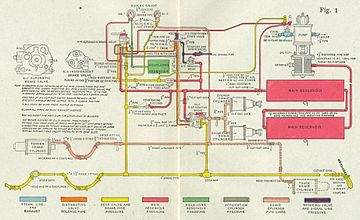
Back Fre Westinghouse Catalan Samočinná tlaková brzda Czech Druckluftbremse (Eisenbahn) German Freno Westinghouse Spanish Paineilmajarru (rautatietekniikka) Finnish Frein automatique French Westinghouse-fék Hungarian Rem udara kereta api ID Freno continuo automatico Westinghouse Italian 空気ブレーキ Japanese
This article has multiple issues. Please help improve it or discuss these issues on the talk page. (Learn how and when to remove these template messages)
|


A railway air brake is a railway brake power braking system with compressed air as the operating medium.[1] Modern trains rely upon a fail-safe air brake system that is based upon a design patented by George Westinghouse on April 13, 1869.[2] The Westinghouse Air Brake Company was subsequently organized to manufacture and sell Westinghouse's invention. In various forms, it has been nearly universally adopted.
The Westinghouse system uses air pressure to charge air reservoirs (tanks) on each car. Full air pressure causes each car to release the brakes. A subsequent reduction or loss of air pressure causes each car to apply its brakes, using the compressed air stored in its reservoirs.[3]
- ^ Wood, W.W. (1920) [first published 1909]. Wood's Westinghouse E-T Air Brake Instruction Pocket Book (second ed.). New York: The Norman W. Henley Publishing Co.
- ^ U.S. patent 88,929
- ^ "SDRM Train Air Brake Description and History". Sdrm.org. Retrieved 2013-07-14.